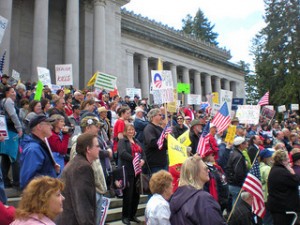What If It Rained on the Tea Party Parade?
My latest Bloomberg View column with Betsey is all about the Tea Party. Well, actually, it’s really about some superb research about the Tea Party, by Andreas Madestam, Daniel Shoag, Stan Veuger and David Yanagizawa-Drott. Their big question: “Do Political Protests Matter? Evidence from the Tea Party.” We know that lots of people turn out to Tea Party rallies. But does it really change anything?
It’s a remarkably difficult question to answer. To see why, think about an analogy: Fenway Park gets big crowds whenever the Red Sox are winning. Is this because they Red Sox players perform better with a big crowd, or is it simply that a winning team generates fan excitement? Likewise, the Tea Party has attracted big crowds to their rallies. But is this mass protest movement a cause or an effect of political foment among their fans?
To disentangle these possibilities, the authors cleverly analyze a very neat natural experiment. The Tea Party was effectively born on Tax Day—April 15, 2009. In some counties sunny skies encouraged large and boisterous rallies. In others, rain suppressed attendance. Comparisons of the political evolution over time of counties where it rained with those where it didn’t, reveal the effects of mobilizing these extra activists.
Their research demonstrates that in politics, success begets success. The initial boost from the weather generated substantial momentum. Counties that enjoyed better weather on tax day had more people sign up to become Tea Party organizers, greater donations to an affiliated political action committee, and larger rallies a year later.
Rallies are one thing. Real political influence is another.
What’s more, the Tea Party experiment shows that the activism catalyzed by those sunny days translates into real political influence. Politicians whose districts were sunny on tax day voted in a more reliably conservative fashion throughout 2009 and 2010. Indeed, the absence of rain in a congressional district on April 15, 2009, made its representative 8.7 percentage points more likely to vote against the Affordable Care Act. Had the weather at those early rallies been sunnier, it’s possible that Obama’s signature legislation wouldn’t have passed.
And the effects of the weather on that one day were also felt at the ballot box:
The Tea Party also changed the makeup of Congress. Sunny days — and thus large rallies in 2009 — led to greater Republican turnout and slightly weaker Democratic participation in the 2010 midterm elections. This boosted the Republican vote share by almost three percentage points in the affected districts. There was even some impact before Election Day: Several Democratic incumbents, seeing the writing on the wall, decided not to seek re-election.
It’s amazing how something as random as the weather on a particular day can have such far-reaching consequences. The authors also tell that as the Occupy movement tried to make a splash beyond Zuccotti Park, the weather also shaped the success of their protests. Hopefully they’ll follow up with another paper that tells us whether that movement was also as effective. But that will need to wait until we know the results of the 2012 elections.
There’s already some suggestive evidence that the Tea Party has had a big effect on the Republican primary race. And Mitt Romney should feel lucky. He eked out close—and pivotal—victories in Ohio and Michigan. In both states, rainy skies on April 15 2009 which likely muted the strength of his Tea Party-supported opponents.
You can read the whole piece here.


Comments